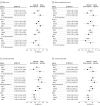Satellite-Based and Street-View Green Space and Adiposity in US Children
- PMID: 39636637
- PMCID: PMC11621986
- DOI: 10.1001/jamanetworkopen.2024.49113
Satellite-Based and Street-View Green Space and Adiposity in US Children
Abstract
Importance: Green space may be associated with obesity outcomes in children by promoting physical activity and reducing stress. However, previous studies have mostly used a single measure of green space and body mass index (BMI) as the sole indicator of adiposity.
Objective: To examine associations of the satellite-based normalized difference vegetation index (NDVI) and street-view imagery-based green space metrics with comprehensive adiposity measures in children.
Design, setting, and participants: The Project Viva cohort study observed participants from mid-childhood (mean [SD] age, 8.0 [0.8] years) and early adolescence (mean [SD] age, 13.3 [1.0] years) through late adolescence (mean [SD] age, 17.8 [0.7] years) between January 1, 2007, and December 31, 2021. This analysis included children with data on green space and adiposity measures. Data were analyzed from January 1 to June 30, 2024.
Exposures: Green space metrics (ie, percentage of trees, grass, and other green space) using street-view imagery and deep learning algorithms along with the NDVI were linked with participants' home addresses during mid-childhood and early adolescence.
Main outcomes and measures: Body mass index (calculated as weight in kilograms divided by height in meters squared) and waist circumference z scores were calculated from anthropometric measurements during early and late adolescence. The total fat mass index (FMI; calculated as fat mass in kilograms divided by height in meters squared) and trunk FMI were obtained using dual-energy x-ray absorptiometry. Separate linear regression models adjusted for a child's age, sex, individual and neighborhood socioeconomic status, and population density estimated prospective associations of the NDVI and street-view green space (in mid-childhood or early adolescence) with 4 adiposity measures (in early or late adolescence).
Results: The sample included 843 children (mean [SD] age at mid-childhood, 7.9 [0.8] years; 423 girls [50.2%]) at baseline. After adjustment for confounders, a higher NDVI (per 1-SD increase) within 270 m in early adolescence was associated with lower z scores for BMI (-0.16 [95% CI, -0.27 to -0.04]) and waist circumference (-0.13 [95% CI, -0.23 to -0.03]), as well as a lower total FMI (-0.62 [95% CI, -1.02 to -0.23]) and trunk FMI (-0.33 [95% CI, -0.55 to -0.12]) in late adolescence. Higher percentages of street-view other green space (flowers, plants, and fields), but not street-view trees and grass, within 500 m in early adolescence were associated with lower BMI z scores (-0.09 [95% CI, -0.18 to -0.01) in late adolescence. The NDVI and street-view green space exposure at mid-childhood were not associated with adiposity measures in early adolescence.
Conclusions and relevance: This cohort study of US children suggests that higher levels of satellite-based NDVI greenness and percentages of street-level green space components (flowers, plants, and fields) were associated with lower adiposity. The findings support the exploration of increasing residential green space levels and adding specific green space components as an urban planning and public health intervention strategy to combat the prevalence of childhood obesity in the US.
Conflict of interest statement
Figures


Similar articles
-
Associations of street-view greenspace exposure with cardiovascular health (Life's Essential 8) among women in midlife.Biol Sex Differ. 2025 Jul 1;16(1):45. doi: 10.1186/s13293-025-00718-3. Biol Sex Differ. 2025. PMID: 40598663 Free PMC article.
-
Associations of Neighborhood Opportunity and Social Vulnerability With Trajectories of Childhood Body Mass Index and Obesity Among US Children.JAMA Netw Open. 2022 Dec 1;5(12):e2247957. doi: 10.1001/jamanetworkopen.2022.47957. JAMA Netw Open. 2022. PMID: 36547983 Free PMC article.
-
Neighborhood Characteristics and Mental Health From Childhood to Adolescence.JAMA Netw Open. 2025 Apr 1;8(4):e254470. doi: 10.1001/jamanetworkopen.2025.4470. JAMA Netw Open. 2025. PMID: 40208593 Free PMC article.
-
Effects of total fat intake on bodyweight in children.Cochrane Database Syst Rev. 2018 Jul 5;7(7):CD012960. doi: 10.1002/14651858.CD012960.pub2. Cochrane Database Syst Rev. 2018. PMID: 29974953 Free PMC article.
-
Interventions to prevent obesity in children aged 5 to 11 years old.Cochrane Database Syst Rev. 2024 May 20;5(5):CD015328. doi: 10.1002/14651858.CD015328.pub2. Cochrane Database Syst Rev. 2024. PMID: 38763517 Free PMC article.
Cited by
-
Prenatal and Perinatal Factors of Life's Essential 8 Cardiovascular Health Trajectories.JAMA Netw Open. 2025 Apr 1;8(4):e257774. doi: 10.1001/jamanetworkopen.2025.7774. JAMA Netw Open. 2025. PMID: 40299384 Free PMC article.
-
Greenspace and depression incidence in the US-based nationwide Nurses' Health Study II: A deep learning analysis of street-view imagery.Environ Int. 2025 Apr;198:109429. doi: 10.1016/j.envint.2025.109429. Epub 2025 Apr 4. Environ Int. 2025. PMID: 40209395 Free PMC article.
-
Associations of street-view greenspace exposure with cardiovascular health (Life's Essential 8) among women in midlife.Biol Sex Differ. 2025 Jul 1;16(1):45. doi: 10.1186/s13293-025-00718-3. Biol Sex Differ. 2025. PMID: 40598663 Free PMC article.
-
Assessing greenspace and cardiovascular health through deep-learning analysis of street-view imagery in a cohort of US children.Environ Res. 2025 Jan 15;265:120459. doi: 10.1016/j.envres.2024.120459. Epub 2024 Nov 26. Environ Res. 2025. PMID: 39603586
References
-
- Yi L, Mason TB, Yang CH, Chu D, Dunton GF. Longitudinal associations between neighborhood park and open space access and children’s accelerometer-assessed measured physical activity: the evidence from the MATCH study. J Phys Act Health. 2021;18(9):1058-1066. doi:10.1123/jpah.2021-0177 - DOI - PMC - PubMed
Publication types
MeSH terms
Grants and funding
LinkOut - more resources
Full Text Sources
Medical

